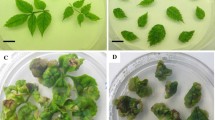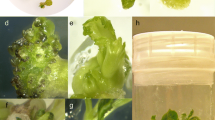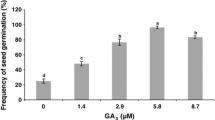Abstract
A plant regeneration protocol was developed for white ash (Fraxinus americana L.). Hypocotyls and cotyledons excised from embryos were cultured on Murashige and Skoog (MS) medium supplemented with 6-benzylaminopurine (BA) plus thidiazuron (TDZ), and compared for organogenic potential. Sixty-six percent of hypocotyl segments and 10.4% of cotyledon segments produced adventitious shoots, with a mean number of adventitious shoots per explant of 3.5 ± 0.9 and 2.5 ± 1.5, respectively. The best regeneration medium (52% shoot formation; 47% shoot elongation) for hypocotyls was MS basal medium containing 22.2 μM BA plus 0.5 μM TDZ, producing a mean of 3.9 ± 0.4 adventitious shoots. Adventitious shoots were established as proliferating shoot cultures following transfer to MS medium with Gamborg B5 vitamins supplemented with 10 μM BA plus 10 μM TDZ. For in vitro rooting, woody plant medium with indole-3-acetic acid (IAA) at 0, 2.9, 5.7, or 8.6 μM in combination with 4.9 μM indole-3-butyric acid (IBA) was tested for a 5- or 10-d dark culture period, followed by culture under a 16-h photoperiod. The best rooting (78% to 81%) of in vitro shoots was obtained with a 5 d dark culture treatment on medium containing 2.9 or 5.7 μM IAA plus 4.9 μM IBA, with an average of 2.6 ± 0.4 roots per shoot. Rooted plants were successfully acclimatized to the greenhouse. This adventitious shoot regeneration and rooting protocol will be used as the basis for experimental studies to produce transgenic white ash with resistance to the emerald ash borer.


Similar content being viewed by others
References
Ashley J. A.; Preece J. E. Seed cutting treatments stimulate germination and elucidate a dormancy gradient in dormant Fraxinus americana L. and Fraxinus pennsylvanica Marsh. Propag. Ornam. Plants 9(3): 122–128; 2009.
Bates S.; Preece J. E.; Navarrete N. E.; Van Sambeek J. W.; Gaffney G. R. Thidiazuron stimulates shoot organogenesis and somatic embryogenesis in white ash (Fraxinus americana L.). Plant Cell Tiss. Org. Cult. 31: 21–29; 1992.
Dobesberger, E. G. Emerald ash borer, Agrilus planipennis: Pest Risk Assessment. Canadian Food Inspection Agency, Plant Health Risk Assessment Unit, Nepean, Ontario, Canada; 2002.
Du N.; Pijut P. M. Regeneration of plants from Fraxinus pennsylvanica hypocotyls and cotyledons. Sci. Hortic-Amsterdam 118: 74–79; 2008.
Griffith, R. S; Fraxinus americana. In: Fire Effects Information System, [Online]. U.S. Department of Agriculture, Forest Service, Rocky Mountain Research Station, Fire Sciences Laboratory (Producer). Available: http://www.fs.fed.us/database/feis/ [2010, August 2]; 1991.
Hammatt N.; Ridout M. S. Micropropagation of common ash (Fraxinus excelsior). Plant Cell Tiss. Org. Cult. 31: 67–74; 1992.
Hicks G.; Browne R. Induction and subculture of callus from petioles of Fraxinus americana (L.), white ash. Proc. N S Inst. Sci. 33: 123–130; 1983.
Kim M. S.; Klopfenstein N. B.; Cregg B. M. In vitro and ex vitro rooting of micropropagated shoots using three green ash (Fraxinus pennsylvanica) clones. New For. 16: 43–57; 1998.
Kim M. S.; Schumann C. M.; Klopfenstein N. B. Effect of thidiazuron and benzyladenine on axillary shoot proliferation of three green ash (Fraxinus pennsylvanica Marsh) clones. Plant Cell Tiss. Org. Cult. 48: 45–52; 1997.
Lloyd G.; McCown B. Commercially feasible micropropagation of mountain laurel, Kalmia latifolia, by use of shoot-tip culture. Proc. Int. Plant Prop. Soc. 30: 421–427; 1980. Publ. 1981.
MacFarlane D. W.; Meyer S. P. Characteristics and distribution of potential ash tree hosts for emerald ash borer. For. Ecol. Mgmt. 213: 15–24; 2005.
McCullough D. G.; Katovich S. A. Pest alert: emerald ash borer. USDA Forest Service State and Private Forestry, Northeastern Area; 2004.
Mitras D.; Kitin P.; Iliev I.; Dancheva D.; Scaltsoyiannes A.; Tsaktsira M.; Nellas C.; Rohr R. in vitro propagation of Fraxinus excelsior L. by epicotyls. J. Biol. Res. - Thessaloniki 11: 37–48; 2009.
Mockeliunaite R.; Kuusiene S. Organogenesis of Fraxinus excelsior L. by isolated mature embryo culture. Acta Univ. Latviensis, Biol. 676: 197–200; 2004.
Murashige T.; Skoog F. A revised medium for rapid growth and bio assays with tobacco tissue cultures. Physiol. Plant. 15: 473–497; 1962.
Navarrete, N. E.; Van Sambeek, J. W.; Preece, J. E.; Gaffney, G. R. Improved micropropagation of white ash (Fraxinus americana L.). In: Rink G.; Budelsky C. A. (eds) Proc 7th Central Hardwood Conf, GTR-NC-132, pp 146–149; 1989.
Nesom, G. Plant guide: white ash, Fraxinus americana L. USDA Natural Resources Conservation Service; 2001.
Perez-Parron M. A.; Gonzalez-Benito M. E.; Perez C. Micropropagation of Fraxinus angustifolia from mature and juvenile plant material. Plant Cell Tiss. Org. Cult. 37: 297–302; 1994.
Poland T. M.; McCullough D. G. Emerald ash borer: invasion of the urban forest and the threat to North America’s ash resource. J. For. 104: 118–124; 2006.
Preece J. E.; Bates S. Somatic embryogenesis in white ash (Fraxinus americana L.). In: Jain S.; Gupta P.; Newton R. (eds) Somatic embryogenesis in woody plants, vol. 2. Kluwer, Netherlands, pp 311–325; 1995.
Preece J. E.; Bates S. A.; Van Sambeek J. W. Germination of cut seeds and seedling growth of ash (Fraxinus spp.) in vitro. Can. J. For. Res. 25: 1368–1374; 1995.
Preece J. E.; Christ P. H.; Ensenberger L.; Zhao J. L. Micropropagation of ash (Fraxinus). Comb. Proc. Int. Plant Prop. Soc. 37: 366–372; 1987.
Preece J. E.; Navarrete N.; Van Sambeek J. W.; Gaffney G. R. An in vitro microplant bioassay using clonal white ash to test for tall fescue allelopathy. Plant Cell Tiss. Org. Cult. 27: 203–210; 1991.
Preece J. E.; Zhao J. L.; King F. H. Callus production and somatic embryogenesis from white ash. HortScience 24: 377–380; 1989.
Schlesinger, R. C. Fraxinus americana L. White ash. In: Burns, R. M.; Honkala, B. H. (Tech Coords), Silvics of North America, Vol. 2, Hardwoods, USDA Forest Service, Agric Handbook 654, Washington, DC; pp 333–338; 1990.
SPSS Inc. SPSS for Windows. Chicago, IL. Ver 17; 2009.
Sydnor T. D.; Bumgardner M.; Todd A. The potential economic impacts of emerald ash borer (Agrilus planipennis) on Ohio, U.S., communities. Arbor Urban For. 331: 48–54; 2007.
Tabrett A. M.; Hammatt N. Regeneration of shoots from embryo hypocotyls of common ash (Fraxinus excelsior). Plant Cell Rep. 11: 514–518; 1992.
Tonon G.; Capuana M.; Di Marco A. Plant regeneration of Fraxinus angustifolia by in vitro shoot organogenesis. Sci. Hortic-Amsterdam 87: 291–301; 2001a.
Tonon G.; Kevers C.; Gaspar T. Changes in polyamines, auxins and peroxidase activity during in vitro rooting of Fraxinus angustifolia shoots: and auxin-independent rooting model. Tree Physiol. 21: 655–663; 2001b.
Van Sambeek J. W.; Preece J. E.; Navarrete-Tindall N. E. Comparative in vitro culture of white and green ash from seed to plantlet production. Comb. Proc. Int. Plant Prop. Soc. 51: 526–534; 2001.
Wallander E. Systematics of Fraxinus (Oleaceae) and evolution of dioecy. Plant Syst. Evol. 273: 25–49; 2008.
Yu C. Agrilus marcopoli Obenberger. In: Xiao G. (ed) Forest insects of China. 2nd ed. China Forestry Publishing House, Beijing, pp 400–401; 1992.
Acknowledgments
The authors gratefully acknowledge Drs. Michael Kane and John E. Preece for their constructive review and suggestions for the improvement of this manuscript.
The mention of a trademark, proprietary product, or vendor does not constitute a guarantee or warranty of the product by the U.S. Department of Agriculture and does not imply its approval to the exclusion of other products or vendors that also may be suitable.
Author information
Authors and Affiliations
Corresponding author
Additional information
Editor: N. J. Taylor
Rights and permissions
About this article
Cite this article
Palla, K.J., Pijut, P.M. Regeneration of plants from Fraxinus americana hypocotyls and cotyledons. In Vitro Cell.Dev.Biol.-Plant 47, 250–256 (2011). https://doi.org/10.1007/s11627-011-9360-9
Received:
Accepted:
Published:
Issue Date:
DOI: https://doi.org/10.1007/s11627-011-9360-9




